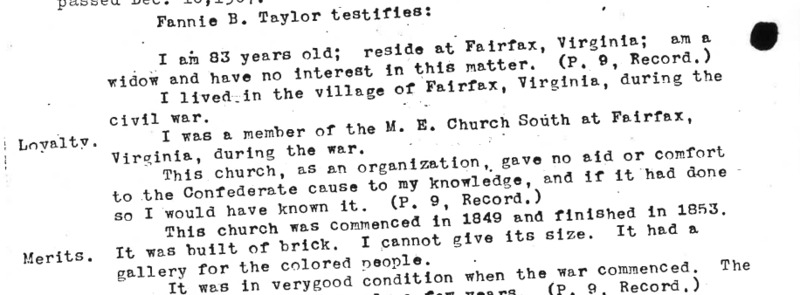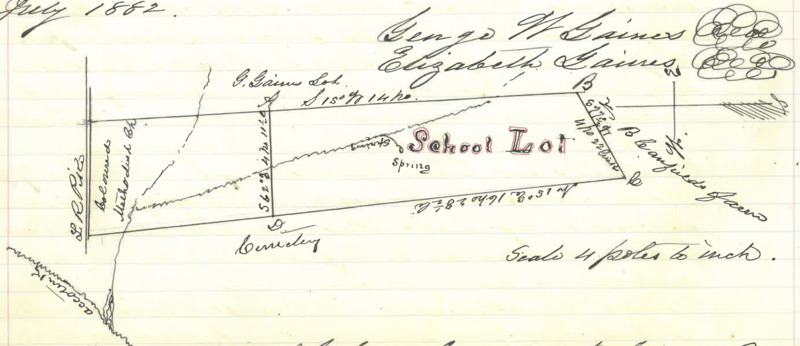Carow Hall and Black Methodist History
George Mason University's Carow Hall, a place as unassuming as any other administrative building on campus, hides a significant history within its walls. With careful attention, one might notice the curious window paning and other nods to 1960s architecture, hinting that the building was once a church. Not just any church, however. Carow Hall once was was home to Fairfax's oldest Black Methodist Church.
This Black Methodist congregation can be traced back over 150 years, with its first appearance in the records of Fairfax County occurring in the mid-1800s. Just south of Fairfax Court House at that time stood a white Methodist Church called Duncan Chapel. Until the Civil War and emancipation, Duncan Chapel contained a gallery for Black folks.[i] It is unclear whether this was used by both free and enslaved African Americans. While this was blatant enforcement of racial segregation, the welcoming of “mixed company” at this time, especially in the center of town was also a clear mark of the congregation's (for their time) progressive ideology.
In 1862, Union troops came to Fairfax and commandeered Duncan Chapel, living in and destroying much of it in battle. After the war ended, congregants filed a Southern Claim, for damage to the building and property. It was the supporting testimony of community members such as Fannie B. Taylor that won them the lawsuit and earned them payment for damages in 1909. Taylor claimed that the church had contained this “gallery for colored people” prior to the war, and that the church never sympathized or sided with the Confederate.[ii]
It didn't take long, after the CW ended, for proponents of the "Lost Cause" myth to begin solidifying their version, both rhetorically and geographically. The Ladies Memorial Association in Fairfax was one such determined organization, and in 1866 they bought land in the same Court House-adjacent area as the chapel. [iii] The Ladies dedicated their plot of land, just west of the Court House and Duncan Chapel for the creation of a Confederate memorial cemetery, where Southern soldiers could be reinterred from distant graves and honored. This cemetery plot, visible on the map above, was eventually given over to the City of Fairfax and still stands today. While a large number of Confederate dead are buried there and a sizable monument remains, it now also serves as the city’s official headquarters of Fairfax Cemetery Association.
At the same time that this Lost Cause legacy was being solidified, one white family in the area helped Black folks solidify their own geography. Farmers and sizable property owners Bleecker Canfield and his wife Harriet began selling their land, which at the time took up much of the area surrounding the Court House which had not already been dedicated or purchased. In 1869, the Canfields sold a plat of land to Duncan Chapel since at this time their property was still in ruins, they had not yet filed the Southern Claim, and had had no home base to worship from.[iv]
The next year, in 1870, the Canfields sold another plot of land to a group of free Black people for the construction of their own Methodist Church and schoolhouse.[v] This congregation likely wished to be able to worship within their own community as well as educate their children, given that most local schools at the time, especially for Black children, met in church spaces. It is in this moment and on this land that the group of Black Methodists began to call themselves Fairfax Methodist Church. We can't know if the Canfields provided for racially segregated churches on the same block for segregationist reasons or progressive ones, but regardless, they enabled Black Methodists to begin building their own.
[i] Duncan Chapel Southern Claim § (1908).
[ii] Ibid.
[iii] Fairfax, Virginia, Land Deeds Book U-4: 62-63, W.M. Ball and the Ladies Memorial Association, 8 March 1875; Fairfax County Circuit Court Historic Records.
[iv] Fairfax, Virginia, Land Deeds Book K-4: 429-430, Bleecker Canfield and Trustees of Methodist Episcopal Church, 15 October 1869; Fairfax County Circuit Court Historic Records.
[v] Fairfax, Virginia, Fairfax Historic Records Deed Book P-4: Pages 435-437, Canfield and Trustees of Colored Methodist Church, 24 December 1870, Fairfax Circuit Court Historic Records.





